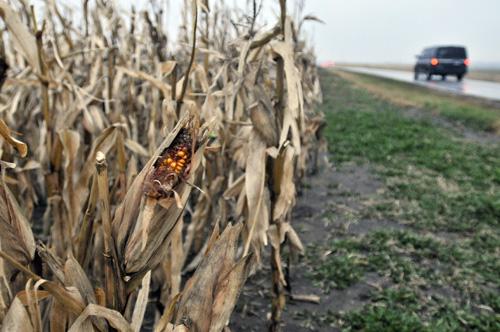Late October freeze helps farmers

Cornstalks stand in a field near Wright Street and Windsor Road in Champaign on Wednesday. The late freeze ended the growing season. Erica Magda
November 13, 2008
Champaign area’s first official freeze was about two weeks late when it finally came Oct. 28.
State Climatologist Jim Angel said the freeze date for East Central Illinois is usually around Oct. 15, so the growing season lasted almost two extra weeks for farmers.
The late freeze was expected, however.
“This is the way the weather works each year,” Angel said. “It varies year to year, so this came as no surprise.”
He said Champaign can expect its first freeze any time in October, but there is no long-term trend as to whether the freeze will come early or late.
Get The Daily Illini in your inbox!
The Oct. 28 freeze was widespread throughout Illinois, but temperatures in the northern parts of the state dropped earlier, Angel said.
Freezes in this area are caused by cold air coming down from Canada. When temperatures in the whole state dropped down to the upper 20s, the water in plants froze and ruined plant cells, he said.
Mosbah Kushad, professor in ACES, said plants die more quickly when a rapid freeze occurs.
With a slow freeze, plants tend to acclimate but they still cannot handle temperatures much below 32 degrees Fahrenheit.
He said, however, farmers are prepared for freezes to occur as soon as October arrives.
“The vast majority of them know that when you reach October, you’re at the mercy of the weather front,” Kushad said.
Emerson Nafziger, professor in Crop Sciences, said the late freeze was beneficial for crops in this area. The planting of corn and soybeans began later this season, so a late freeze gave the crops more time to mature.
“Development this season was even slower than it usually is,” Nafziger said. “Farmers were very concerned that it would frost early and kill the plants before they matured.”
He said if the freeze had come at its normal time, it would not have killed a lot of crops, but it was still a good thing the freeze happened later in the month.
This season was also characterized by heavy rainfall. From January to October, the precipitation total was 45.3 inches, making it the second wettest January to October on record, according to Angel.
“We had too much rain in many cases, especially early in the season,” Nafziger said. “It damaged crops.”
Many crops had to be replanted, he added.
Although this season had its share of troubles, Nafziger said the corn and soybean yields will be among the highest on record.
“The season was good enough for long enough,” he said. “Even though the crops were developing slowly, we had a good September and October.”
Kushad said he agreed that it had been a good crop in general.
“Overall, this has been a really good season for growers,” he said.






